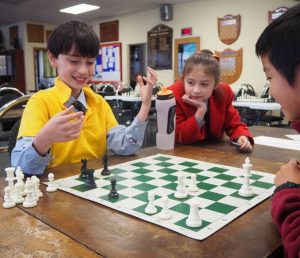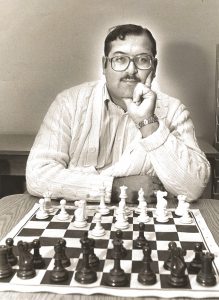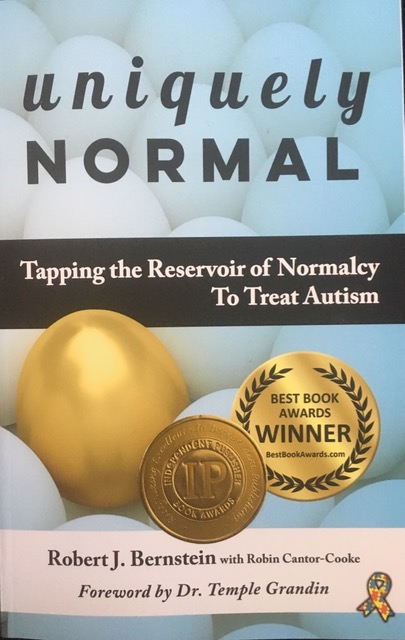By Rob Bernstein, Founder of RJB Educational Services

What is so special about chess? How is it different from other games, and how can it open a window into the mind of a person with autism? 
If you want to understand a child on the autism spectrum, you need to understand how his mind works. We can observe this in how the child plays games. Is he obsessive, inflexible, or impulsive? Is he considerate of others? Is he fair? Does he have to win? Is he a good looser? Does he want to learn? Does he take criticism well? Does she like to think? Does she like to figure things out? Does she appreciate her opponent’s terrific move? You get the idea.
As complicated as the mind is, chess can be reflective of many of its variations. The game is sophisticated enough to give me insight into how the person’s mind is working. Of course, making a peanut butter sandwich will give me insight as well, but not quite as much as chess.
Let me give you an example of a bright teen who, in addition to autism, had what is called obsessive defiant behavior, which means, at least in this case, that he basically hated everyone. His parents, quite wealthy, were going to send him to a residential school in England. Now remember, I use chess therapeutically, so the way I use the game may be a little different from the way you normally play, as in the following example.
We were about eight moves into the game and I asked 15-year-old James, “What’s your plan?” He said that that he was going to move his rooks out and put me in check. So I moved so he could move his rooks. James made no progress toward his goal on his next move. I moved again so I wouldn’t interfere with his plan. Still nothing. After a third move I said, “I can understand you not listening to your mother because she had an affair with a man when you were ten years old. [The man later became his stepfather.] I can understand you not listening to your therapist because she never connected with you. I understand you not listening to your teachers because they have no compassion for you. But you’re not even listening to yourself!” James’s demeanor changed––he went from “You’re just another therapist who only sees my flaws” to “Wow, yeah, you’re right, you got me.” Then he asked me the pivotal question: “How long do you think it would take for me to get better?” I interpreted his question to mean better with how he saw himself as a person. I said, “Because you’re asking that question, it won’t take that long.” It was already May. I saw James for about a month, and then the family had the summer off. In September, I waited a couple weeks into the school year for the parents to call me. I was surprised that they did not because I thought we were doing really well in our work. These were the only parents I ever called back in this situation. They said, “This is a success case.” There was no problem––James was considerate at home and doing great in school. I responded that there was no need to see me again unless there was a regression. I never heard from them again. The point is that chess gave me insight into James’s mind, and more importantly it gave him insight into his own mind. Why was this impactful? I was not telling him anything––all he needed to do was look at the chessboard. The board does not lie!
I’ve worked with thousands of people on the autism spectrum and have used chess with hundreds of them. I never used this exact scenario with anyone else. Everyone is different and chess is sophisticated enough to capture many aspects of how a person thinks.
At the Intrepid Museum in New York City, once a year, at least in prepandemic times,
they had chess masters play kids in simultaneous exhibitions. The games were well worth the two-hour wait. My kids played a terrific guy, International Master Danny Kopec, who unfortunately passed away a few years ago.  I once gave a talk at the Intrepid on using chess therapeutically, illustrated with some video examples. I showed a video of an eight-year-old who wanted to move his knight out to free up his bishop, but moved so two of my pawns could take his knight! I pointed this out and encouraged him to take back the move. He made the same move twice more!! Why? Because he could only think of the game from his point of view. He wanted to free up his bishop and couldn’t think past that. What his opponent could do as a result of his move was the last thing in his mind.
I once gave a talk at the Intrepid on using chess therapeutically, illustrated with some video examples. I showed a video of an eight-year-old who wanted to move his knight out to free up his bishop, but moved so two of my pawns could take his knight! I pointed this out and encouraged him to take back the move. He made the same move twice more!! Why? Because he could only think of the game from his point of view. He wanted to free up his bishop and couldn’t think past that. What his opponent could do as a result of his move was the last thing in his mind.
Giving the child chance after chance to understand the opponent’s point of view trains his mind to think differently. Telling him “You are not considering me” may make me feel that I’m trying to teach him to change his way of thinking, but allowing him to change his thinking himself is much more effective.
I sometimes ask my clients if they want to have a learning game. If they say no, it tells me something—perhaps they have difficulty accepting making mistakes. If they say yes, I teach them to play, but for me chess is not the real agenda. I’m just using chess as a vehicle to see if I can help the child change the way he thinks to function more independently.
In case it’s not obvious, I teach chess, math, and just about everything else conceptually. The opposite of a conceptual approach, a rote-memorization behavioral approach, is kind of meaningless. Autistic kids often need to know why. In fact some of them insist on knowing why. Why do pawns move two squares from their home spot? That could seem weird to a kid––and why should a kid accept a rule just for the rule’s sake when there could be an explanation behind the idea?
I went to a meeting with the school staff after my client got suspended for pushing an aide who was in the way of him getting a second brownie. The class made 150 brownies to sell at an event. Each kid was allowed to have one brownie. I asked the teacher at the meeting, “Why couldn’t he get another brownie? You made 150 of them.” She said, “Because I said so.” Well, that may be fine for most kids, but it often is not good enough for kids on the spectrum, who may be a little inflexible.
Getting back to moving the pawn two spaces, I have an explanation that I think brings the child closer to the game of chess. I explain that in the early days of the game, the rule was to only go one space, as you would expect. The players would move the pawn one space on its first move, and then another space on the next move. After a while, it just made sense to make a rule that for its first move, a pawn can move two spaces if unobstructed. But guess what? It’s not fair to the opposing pawn who worked really hard to get into a position to take the other pawn if it moved just one square. So to be fair to that pawn, we needed to add the en passant rule. Now, it all makes sense––moving the pawn two spaces on the first move is not just a rule you need to follow for no reason.
In my 35 years of working with kids on the autism spectrum, I have found that chess can be used to help diagnosis a child’s thinking and behavior patterns, as well as treating these issues.
*If you are thinking of using the term “Chess Therapy,” think again, because I have intellectual rights to it.
Rob Bernstein has worked with thousands of people on the autism spectrum and is the author of Uniquely Normal: Tapping the Reservoir of Normalcy to Treat Autism.



Hey, I read your article and i must say its really helpful. I would like to mention a <a href="[Link deleted]SEARCH ENGINE WEBSITE . Do check out their blog on <a href="[Link deleted]- A GAME ABOUT STRATEGY AND PLANNING
Thanks for your good content
so interesting content here
I needed to thank you for this excellent read!!
Very interesting article. I just would like to add a comment about the (very) positive influence of chess in ADHD diagnosed persons. I am manager of the ADHD & Chess project, where you can find lots of information about this subject. I am willing to help and answer questions if needed. Kind regards
Epic adventures await – start your journey today.
You have the rights to nothing.And I’d am happy to prove it to you.
Discover the ultimate gaming experience with our immersive online casino games. <a href="[Link deleted]Cola
𝕤𝕓𝕕𝕣𝕖𝕖𝕧𝕖@𝕘𝕞𝕒𝕚𝕝.𝕔𝕠𝕞
𝕧𝕖𝕣𝕪 𝕚𝕟𝕥𝕖𝕣𝕖𝕤𝕥𝕖𝕕
Play with confidence at our licensed and regulated casino!
Big wins are just a click away! Play now and turn your luck around! Big Wins Online Gambling <a href="[Link deleted]Cola
Unleash your hero in the most epic online game!
Battle for glory and eternal fame! <a href="[Link deleted]
Epic adventures await – start your journey today.
Epic adventures await – start your journey today.
Very fascinating article. The (very) beneficial effects of chess on people with ADHD are something I’d like to mention. You can discover a wealth of information on this issue on the ADHD & Chess initiative, which I oversee. Feel free to ask me anything or get my assistance if you need it. My warm regards
You have my deepest gratitude for the encouragement you gave me to maintain an optimistic outlook and for the help you gave me to advance professionally.
You can perform epic tricks while racing through a series of hazardous tracks.
Escape into epic worlds and thrilling gameplay – join now
Chess may be a complete therapy for people with autism
This blog post is a gem! Your ability to address relevant topics while providing clear, practical solutions is truly impressive. I’ve already started implementing some of the suggestions you’ve shared, and they’re making a noticeable difference. Thank you for creating content that is both thoughtful and empowering. Your blog is a fantastic resource, and I’ll definitely be returning for more insights. Keep up the excellent work!
I will follow your blogs and share them with everyone since this is a fantastic source of knowledge. I think highly of the author of this piece; you are quite skilled. I hope you will spread the word about them and find more success.
I thoroughly enjoyed this post and found it incredibly informative. The author’s ability to break down concepts made learning effortless.
Downloading TikTok videos without a watermark violates the platform’s usage rules because the content belongs to the creator and cannot be shared without permission.
This is a powerful reminder of how something as simple as a game of chess can become a window into the mind—especially for children on the autism spectrum. Insightful, compassionate, and deeply human.
This article offers such a unique perspective on chess and autism—really insightful! I’ve always believed games reveal so much about how we think, and chess seems like a perfect mirror for the mind. It’s fascinating how something as simple as a game can unlock such deep understanding. Speaking of mirrors, the <a href="[Link deleted]Beauty Filter also reflects beauty in unexpected ways, much like how chess reflects the mind. Great read!
Great read on chess and autism! Chess really does offer a unique window into cognitive patterns. I’ve seen how strategic games like chess and even <a href="[Link deleted]games can help kids develop focus and flexibility. The parallels you’ve drawn here are insightful—games truly reveal so much about how a child thinks and learns. Thanks for sharing this perspective!
“Wow, what a thought-provoking read! Chess truly is a window into the mind, especially for kids on the autism spectrum. I love how you highlight the way the game reveals so much about thinking patterns and social skills—it’s way more than just strategy. As someone who’s seen chess help with focus and patience firsthand, this really resonates. Keep shining a light on these powerful connections!”
This article offers such a thoughtful perspective on chess and autism! I’ve always believed chess is more than just a game—it’s a mirror of how we think and react. The way it reveals a child’s problem-solving style and emotional responses is truly fascinating. It makes me wonder how often we overlook simple tools like chess that can teach us so much about the mind. A brilliant read!
This article beautifully highlights chess as a unique window into understanding autism. As someone who’s seen the transformative power of chess in education, I find it fascinating how the game mirrors cognitive and social patterns. It’s not just about moves—it’s about unlocking how minds engage, struggle, and grow. A thought-provoking read for educators and parents alike!
This is such a thoughtful exploration of chess’s unique role in understanding autism. The way chess mirrors cognitive patterns really shows its therapeutic potential beyond just being a game—it’s like a window into nuanced thinking styles. As someone who’s seen how structured activities can help with developmental growth, I appreciate how this highlights chess as a tool for both insight and connection. The comparison to everyday tasks like making a sandwich perfectly illustrates its depth. Really valuable perspective!
At the heart of this website lies a dedication to making ironmongery an accessible art, reflecting a heritage rooted in the 1970s, where design excellence and a commitment to quality began shaping the company’s mission, ensuring every handle, hinge, or latch is not merely a utility but an integral piece of a design puzzle within homes, offices, and commercial spaces.
Jump into real-time action Download this free online game now
I am so happy to have come onto this useful page. I learn a great deal of fascinating facts from it about everything that’s happening, particularly the topic of the article that came just before this one.
Wondering how to start a vegetable garden? Join Grow A Garden and begin planting fresh crops while learning real farming strategies.
Find your perfect game match here
Fascinating concept—using chess as a therapeutic tool for autism is truly inspiring.
I love how you highlighted both the cognitive and emotional benefits.
It’s heartwarming to see chess being used as more than just a game.
This could be so valuable for educators and therapists alike.
Thanks for the great insights! I was just researching solutions for a client, and this information is really helpful, especially when considering commercial overhead door repair options.
Шахматная терапия отличный способ развивать внимание и обучение у детей с аутизмом. Практические занятия, такие как 3D-печать, также могут помочь, подробнее здесь <a href="[Link deleted]слайсер настройки
Шахматы помогают детям с аутизмом развивать концентрацию и умственные способности. Интересные проекты с 3D-печатью могут это дополнить.
Their team’s thorough understanding and proactive communication make complex projects feel effortless and well-managed.구글찌라시 The quality and precision demonstrated here reflect true mastery and a genuine dedication to excellence in every project.
Franchement, bloquer les bots sur l’USG-50, c’est pas toujours évident. Y’a des paramètres qu’on laisse passer, et après c’est l’anarchie.
This is such an interesting perspective on chess as a diagnostic tool. I’ve noticed my nephew (on the spectrum) shows remarkable focus during chess, yet struggles with turn-taking in other games. Could this structured predictability be key?
Trust this expert team to provide innovative solutions paired with a strong focus on quality and integrity.강남쩜오 Their innovative strategies and clear communication inspire confidence and ensure superior results across all engagements.
Compassionate condolence message and AI-powered generator to help you express sympathy during difficult times
Make every query count by using Pinpoint Answer Today — optimized for clear, reliable answers.
1. Make square face portraits effortlessly with square face generator — a simple web tool for crisp, realistic style.